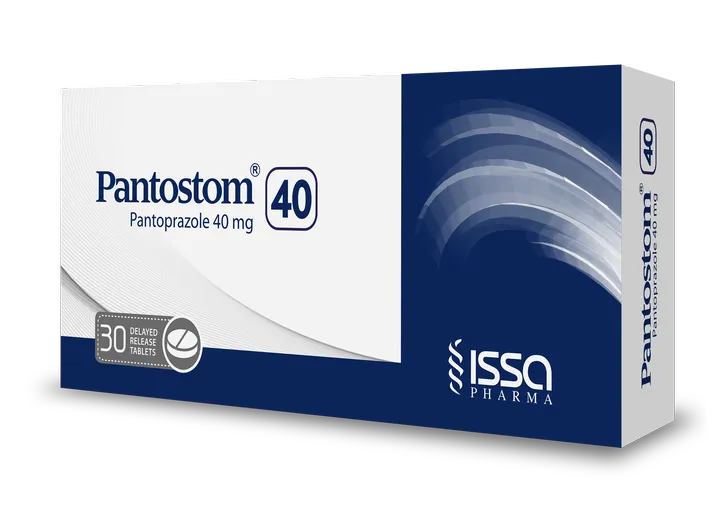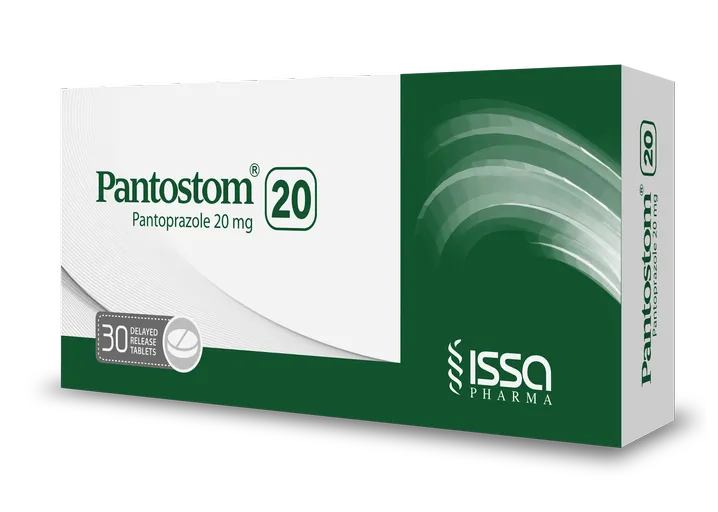COMPOSITION AND EXCIPIENTS
Active Ingredient:
- Each delayed-release tablet of Pantostom 20 contains 20 mg pantoprazole (equivalent to 22.56 mg of pantoprazole sodium).
- Each delayed-release tablet of Pantostom 40 contains 40 mg pantoprazole (equivalent to 45.1 mg of pantoprazole sodium).
Excipients:
Tablet: Calcium Stearate, Crospovidone, Mannitol, Povidone, Sodium lauryl sulfate, Sodium carbonate.
Coating layer: Methacrylic acid copolymer, Hypromellose, Polysorbate 80, Propylene glycol, Triethyl citrate, Titanium dioxide, Iron oxide Yellow (For 20 mg), Iron oxide Red (For 40 mg).
MECHANISM OF ACTION
Pantoprazole is a PPI that suppresses the final step in gastric acid production by covalently binding to the (H+ , K+ )-ATPase enzyme system at the secretory surface of the gastric parietal cell. This effect leads to inhibition of both basal and stimulated gastric acid secretion, irrespective of the stimulus. The binding to the (H+ , K+ )-ATPase results in a duration of antisecretory effect that persists longer than 24 hours for all doses tested (20 mg to 120 mg).
PHARMACOKINETICS
Pantoprazole Delayed-Release Tablets are prepared as enteric-coated tablets so that absorption of pantoprazole begins only after the tablet leaves the stomach. Peak serum concentration (C max) and area under the serum concentration time curve (AUC) increase in a manner proportional to oral and intravenous doses from 10 mg to 80 mg. Pantoprazole does not accumulate, and its pharmacokinetics are unaltered with multiple daily dosing. Following oral or intravenous administration, the serum concentration of pantoprazole declines exponentially, with a terminal elimination half-life of approximately one hour.
Absorption: After administration of a single or multiple oral 40 mg doses of Delayed-Release Tablets ,the peak plasma concentration of pantoprazole was achieved in approximately 2.5 hours, and C max was 2.5 μg/mL. Pantoprazole undergoes little first-pass metabolism, resulting in an absolute bioavailability of approximately 77%. Pantoprazole absorption is not affected by concomitant administration of antacids.
Administration of Delayed-Release Tablets with food may delay its absorption up to 2 hours or longer; however, the Cmax and the extent of pantoprazole absorption (AUC) are not altered. Thus, Pantoprazole Delayed-Release Tablets may be taken without regard to timing of meals.
Distribution: The apparent volume of distribution of pantoprazole is approximately 11 to 23.6 L, distributing mainly in
extracellular fluid. The serum protein binding of pantoprazole is about 98%, primarily to albumin.
Metabolism: Pantoprazole is extensively metabolized in the liver through the cytochrome P450 (CYP) system.
Excretion: After a single oral or intravenous dose of 14C-labeled pantoprazole to healthy, normal metabolizer
subjects, approximately 71% of the dose was excreted in the urine, with 18% excreted in the feces through biliary excretion. There was no renal excretion of unchanged pantoprazole.
Geriatric Patients: Only slight to moderate increases in the AUC (43%) and Cmax (26%) of pantoprazole were found in
elderly subjects (64 to 76 years of age) after repeated oral administration, compared with younger
subjects. no dosage adjustment is warranted.
Children and Adolescents 6 through 16 Years of Age: The pharmacokinetics of Pantoprazole Delayed-Release Tablets were evaluated in children ages 6 through 16 years with a clinical diagnosis of GERD. The PK parameters following a single oral dose of 20 mg or 40 mg of Pantoprazole tablets in children ages 6 through 16 years were highly variable(%CV ranges 40 to 80%). The geometric mean AUC estimated from population PK analysis after a 40 mg Pantoprazole tablet in pediatric patients was about 39% and 10% higher respectively in 6 to 11 and12 to 16 year-old children, compared to that of adults.
Male and Female Patients: There is a modest increase in pantoprazole AUC and Cmax in women compared to men. However, weight-normalized clearance values are similar in women and men.
Patients with Renal Impairment: In patients with severe renal impairment, pharmacokinetic parameters for pantoprazole were similar to those of healthy subjects.
Patients with Hepatic Impairment: Pharmacokinetic changes in hepatic-impaired patients result in minimal drug accumulation following once-daily, multiple-dose administration, where no dosage adjustment is warranted.
Doses higher than 40 mg/day have not been studied in hepatically impaired patients.
INDICATIONS
Pantostom Delayed-Release Tablets are indicated for:
- Short-Term Treatment of Erosive Esophagitis Associated With Gastroesophageal Reflux
Disease (GERD) :Pantostom is indicated in adults and pediatric patients five years of age and older for the short-term
treatment (up to 8 weeks) in the healing and symptomatic relief of erosive esophagitis (EE). For those adult patients who have not healed after 8 weeks of treatment, an additional 8-week course of Pantoprazole may be considered. Safety of treatment beyond 8 weeks in pediatric patients has not been established. - Maintenance of Healing of Erosive Esophagitis :Pantostom is indicated for maintenance of healing of EE and reduction in relapse rates of daytime and nighttime heartburn symptoms in adult patients with GERD. Controlled studies did not extend beyond 12 months.
- Pathological Hypersecretory Conditions Including Zollinger-Ellison Syndrome: Pantostom is indicated for the long-term treatment of pathological hypersecretory conditions,including Zollinger-Ellison (ZE) Syndrome.
ADMINISTRATION
Indication | Dose | Frequency |
Short-Term Treatment of Erosive Esophagitis Associated With GERD: | ||
Adults | 40 mg | Once daily for up to 8 weeks |
Children (5 years and older) | Once daily for up to 8 weeks | |
≥ 15 kg to < 40 kg | 20 mg | |
≥ 40 kg | 40 mg | |
Maintenance of Healing of Erosive Esophagitis: | ||
Adults | 40 mg | Once daily |
Pathological Hypersecretory Conditions Including Zollinger-Ellison Syndrome: | ||
Adults | 40 mg | Twice daily |
Dosage regimens should be adjusted to individual patient needs and should continue for as long as clinically indicated. Doses up to 240 mg daily have been administered.
Administration Instructions:
Swallow Pantostom Delayed-Release Tablets whole, Do not split, chew, or crush with or without food in the stomach. For patients unable to swallow a 40 mg tablet, two 20 mg tablets may be taken. Concomitant administration of antacids does not affect the absorption of Pantoprazole Delayed-Release Tablets. Take a missed dose as soon as possible. If it is almost time for the next dose, skip the missed dose and take the next dose at the regular scheduled time. Do not take 2 doses at the same time.
CONTRAINDICATIONS
Pantoprazole is contraindicated in patients with known hypersensitivity to any component of the formulation or any substituted benzimidazole. Hypersensitivity reactions may include anaphylaxis, anaphylactic shock, angioedema, bronchospasm, acute interstitial nephritis, and urticaria.
Proton pump inhibitors (PPIs), including pantoprazole, are contraindicated with rilpivirine-containing products.
WARNINGS AND PRECAUTIONS
Presence of Gastric Malignancy:
In adults, symptomatic response to therapy does not preclude the presence of gastric malignancy. Consider additional follow-up and diagnostic testing in adult patients who have a suboptimal response or an early symptomatic relapse after completing treatment with a PPI. In older patients, also consider an endoscopy.
Acute Interstitial Nephritis:
Acute interstitial nephritis has been observed in patients taking PPIs including this drug. Acute interstitial nephritis may occur at any point during PPI therapy and is generally attributed to an idiopathic hypersensitivity reaction. Discontinue the drug if acute interstitial nephritis develops.
Clostridium difficile-Associated Diarrhe:
Published observational studies suggest that PPI therapy like this drug may be associated with an
increased risk of Clostridium difficile associated diarrhea, especially in hospitalized patients. This
diagnosis should be considered for diarrhea that does not improve. Patients should use the lowest dose and shortest duration of PPI therapy appropriate to the condition being treated.
Bone Fracture: Several published observational studies suggest that PPI therapy may be associated with an increased
risk for osteoporosis-related fractures of the hip, wrist, or spine. The risk of fracture was increased in patients who received high-dose, defined as multiple daily doses, and long-term PPI therapy (a year or longer). Patients should use the lowest dose and shortest duration of PPI therapy appropriate to the condition being treated.
Cutaneous and Systemic Lupus Erythematosus: Cutaneous lupus erythematosus (CLE) and systemic lupus erythematosus (SLE) have been reported in patients taking PPIs, including pantoprazole sodium. These events have occurred as both new onset and an exacerbation of existing autoimmune disease. The majority of PPI-induced lupus erythematous cases were CLE.
The most common form of CLE reported in patients treated with PPIs was subacute CLE (SCLE) and
occurred within weeks to years after continuous drug therapy in patients ranging from infants to the elderly.
Generally, histological findings were observed without organ involvement.
Avoid administration of PPIs for longer than medically indicated. If signs or symptoms consistent with CLE or SLE are noted in patients receiving the drug , discontinue the drug and refer the patient to the appropriate specialist for evaluation. Most patients improve with discontinuation of the PPI alone in 4 to 12 weeks. Serological testing (e.g. ANA) may be positive and elevated serological test results may take longer to resolve than clinical manifestations.
Cyanocobalamin (Vitamin B-12) Deficiency :
Generally, daily treatment with any acid-suppressing medications over a long period of time (e.g.,longer than 3 years) may lead to malabsorption of cyanocobalamin (Vitamin B-12) caused by hypo- or achlorhydria. Rare reports of cyanocobalamin deficiency occurring with acid-suppressing therapy have been reported in the literature. This diagnosis should be considered if clinical symptoms consistent with cyanocobalamin deficiency are observed.
Hypomagnesemia:
Hypomagnesemia, symptomatic and asymptomatic, has been reported rarely in patients treated with PPIs for at least three months, and in most cases after a year of therapy. Serious adverse events include tetany, arrhythmias, and seizures. In most patients, treatment of hypomagnesemia required magnesium replacement and discontinuation of the PPI.
For patients expected to be on prolonged treatment or who take PPIs with medications such as digoxin or drugs that may cause hypomagnesemia (e.g., diuretics), health care professionals may consider monitoring magnesium levels prior to initiation of PPI treatment and periodically.
Tumorigenicity :
Due to the chronic nature of GERD, there may be a potential for prolonged administration of Pantoprazole. In long-term rodent studies, pantoprazole was carcinogenic and caused rare types of gastrointestinal tumors. The relevance of these findings to tumor development in humans is unknown.
Fundic Gland Polyps :
PPI use is associated with an increased risk of fundic gland polyps that increases with long-term use, especially beyond one year. Most PPI users who developed fundic gland polyps were asymptomatic and fundic gland polyps were identified incidentally on endoscopy. Use the shortest duration of PPI therapy appropriate to the condition being treated.
Interference with Investigations for Neuroendocrine Tumors :Serum chromogranin A (CgA) levels increase secondary to drug-induced decreases in gastric acidity. The increased CgA level may cause false positive results in diagnostic investigations for neuroendocrine tumors. Healthcare providers should temporarily stop Pantoprazole treatment at least 14 days before assessing CgA levels and consider repeating the test if initial CgA levels are high.
Interference with Urine Screen for THC:
There have been reports of false-positive urine screening tests for tetrahydrocannabinol (THC) in patients receiving PPIs, including this drug.
Concomitant Use of with Methotrexate: Literature suggests that concomitant use of PPIs with methotrexate (primarily at high dose) may elevate and prolong serum levels of methotrexate and/or its metabolite, possibly leading to methotrexate toxicities. In high-dose methotrexate administration, a temporary withdrawal of the PPI may be considered in some patients.
ADVERSE REACTIONS
The following serious adverse reactions are described below:
- Acute Interstitial Nephritis.
- Clostridium difficile-Associated Diarrhea.
- Bone Fracture.
- Cutaneous and Systemic Lupus Erythematosus.
- Cyanocobalamin (Vitamin B-12) Deficiency.
- Hypomagnesemia.
- Fundic Gland Polyps.
Clinical Trials Experience:
Headache, diarrhea, Nausea, Abdominal pain, Vomiting, Flatulence, Dizziness, Arthralgia.
Additional adverse reactions that were reported for in clinical trials with a frequency of ≤2% are listed below by body system:
Body as a Whole: allergic reaction, pyrexia, photosensitivity reaction, facial edema.
Gastrointestinal: constipation, dry mouth, hepatitis.
Hematologic:
leukopenia, thrombocytopenia.Metabolic/Nutritional: elevated CK (creatine kinase), generalized edema, elevated triglycerides, liver.
enzymes elevated.
Musculoskeletal:
myalgia.
Nervous:
depression, vertigo.
Skin and Appendages:
urticaria, rash, pruritus.
Special Senses:
blurred vision.
DRUG INTERACTIONS
Antiretrovirals: The effect of PPIs on antiretroviral drugs is variable. The clinical importance and the mechanisms behind the seinteractions are not always known. Decreased exposure of some antiretroviral drugs (e.g. rilpivirine, atazanavir, and nelfinavir) when used concomitantly with pantoprazole may reduce antiviral effect and promote the development of drug resistance. Increased exposure of other antiretroviral drugs (e.g. saquinavir) when used concomitantly with pantoprazole may increase toxicity of the antiretroviral drugs.
There are other antiretroviral drugs which do not result inclinically relevant interactions with pantoprazole.
Rilpivirine-containing products: Concomitant use with is contraindicated.
Atazanavir : See prescribing information for atazanavir for dosing information.
Nelfinavir : Avoid concomitant use with. See prescribing information for nelfinavir.
Saquinavir : See the prescribing information for saquinavir and monitor for potential saquinavir toxicities.
Other antiretrovirals : See prescribing information.
Warfarin: Increased INR and prothrombin time in patients receiving PPIs, including pantoprazole , and warfarin concomitantly. Increases in INR and prothrombin time may lead to abnormal bleeding and even death.
Monitor INR and prothrombin time. Dose adjustment of warfarin may be needed to maintain target INR range.
Clopidogrel: Concomitant administration of pantoprazole and clopidogrel inhealthy subjects had no clinically important effect on exposure to the active metabolite of clopidogrel or clopidogrel induced platelet inhibition.
No dose adjustment of clopidogrel is necessary when administered with an approved dose of Pantoprazole.
Methotrexate: Concomitant use of PPIs with methotrexate (primarily at high dose) may elevate and prolong serum concentrations of methotrexate and/or its metabolite hydroxymethotrexate, possibly leading to methotrexate toxicities. No formal drug interaction studies of high-dose methotrexate with PPIs have been conducted.
A temporary withdrawal of may be considered in some patients receiving high-dose methotrexate.
Drugs Dependent on Gastric pH for Absorption (e.g., iron s alts ,erlotinib, dasatinib, nilotinib, mycophenolate mofetil, ketoconazole/itraconazole): Pantoprazole can reduce the absorption of other drugs due to its effect on reducing intragastric acidity.
Mycophenolate mofetil (MMF): Co-administration of pantoprazole sodium in healthy subjects and in transplant patients receiving MMF has been reported to reduce the exposure to the active metabolite, mycophenolic acid (MPA),possibly due to a decrease in MMF solubility at an increased gastric pH. Use with caution in transplant patients receiving MMF.
Interactions with Investigations of Neuroendocrine Tumors: CgA levels increase secondary to PPI-induced decreases in gastric acidity. The increased CgA level may cause false positive results in diagnostic investigations forneuroendocrine tumors.
Temporarily stop treatment at least 14 days before assessing CgA levels and consider repeating the test if initial CgA levels are high.
False Positive Urine Tests for THC: There have been reports of false positive urine screening tests for tetrahydrocannabinol (THC) in patients receiving PPIs.
An alternative confirmatory method should be considered to verify positive results.
Pregnancy:
Pregnancy Category C
There are no adequate and well-controlled studies in pregnant women. Advise pregnant women of the potential risk of fetal harm. Because animal reproduction studies are not always predictive of human response, this drug should be used during pregnancy only if the potential benefit justifies the potential risk to the fetus.
Nursing Mothers :
Pantoprazole and its metabolites are excreted in the milk of rats. Pantoprazole excretion in human milk has been detected in a study of a single nursing mother after a single 40 mg oral dose of pantoprazole sodium. Based on the potential for tumorigenicity shown for pantoprazole sodium in rodent carcinogenicity studies, a decision should be made whether to discontinue nursing or to discontinue the drug, taking into account the benefit of the drug to the mother.
OVERDOSAGE
Experience in patients taking very high doses of Pantoprazole (greater than 240 mg) is limited.
Spontaneous post-marketing reports of overdose are generally within the known safety profile of. Pantoprazole. Pantoprazole is not removed by hemodialysis. In case of overdosage, treatment should be symptomatic and supportive. Single oral doses of pantoprazole at 709 mg/kg, 798 mg/kg, and 887 mg/kg were lethal to mice, rats, and dogs, respectively. The symptoms of acute toxicity were hypoactivity, ataxia, hunched sitting, limbs play, lateral position, segregation, absence of ear reflex, and tremor.
STORAGE CONDITIONS
Store at temperature between 15° and 30 C°
PACKAGING
Pantostom (20 – 40) mg is supplied as blister strips (Aluminum – White P.V.D.C), each strip contains 10 D.R. Tablets and each pack contains 2 or 3 strips with enclosed leaflet (20 or 30 D.R. Tablets per pack).



